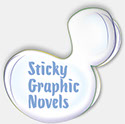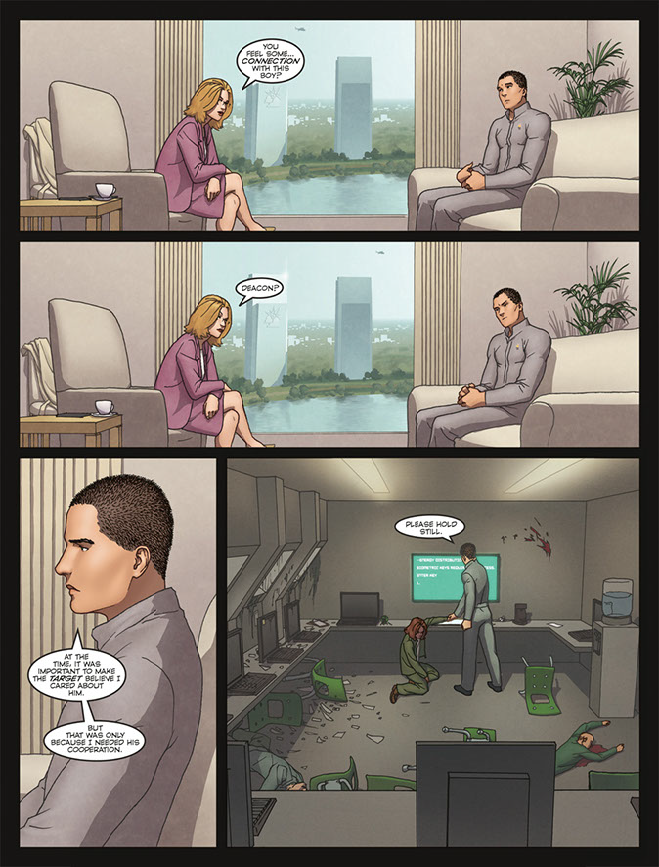- GUTTERFAGS -
Quarterly reviews of sequential art about
dude-on-dude lust and love
-- Back to the front page for more reviews!
Gutterfags is sponsored by Sticky Graphic Novels, an imprint of gay character-based, sex-positive graphic novels published in hardcover by Bruno Gmünder GmbH and in digital format by Class Comics.


Artifice
by Alex Woolfson and Winona Nelson
reviewed by Mike Martinez for Gutterfags
Artifice is a story that has great promise that simply falls short. The premise is about a manufactured human who goes on “assignment” for an evil corporation to put an end to some discovered secret on a distant planet. That he finds love amidst the carnage that ensues is not unbelievable, but never feels fully developed. Artifice was originally a web-comic; the author and artist had a real chance to revise and fill in the blanks web-comics often have. They missed that chance when moving to a graphic novel format.
The story opens on a framing sequence that takes place after the main action: a male manufactured human, who has an ID number but calls itself Deacon, is debriefed by a corporate “therapist” after he is recovered from the mission that makes the bulk of Artifice’s narrative. Deacon relates to his “therapist” that, during his mission, he met Jeff, a human male and, over the course of determining Jeff was not a threat to something described as “the secret”, Deacon begins to explore his own sexuality with the lone human survivor. Jeff reveals to Deacon that he was outcast from his society because he was born gay and not genetically-corrected in utero. Real emotion develops between the pair and a relationship grows between them in the usual fashion of a romance novel: they go from distrust, to understanding, and finally to love. There are a number of clichés at play in Artifice; some forgivable, others should have been laid aside. Its one difference with standard “artificial” life stories is the manufactured humans are not “programmed” to protect human life at all costs. Here they’re programmed to protect corporate interests. The manufactured humans were deliberately engineered to do as told even if that means mass murder to protect a corporation and put human life far down their protection directives.
Despite the book’s principal desire to develop a romance between its protagonists, other elements layered onto the book undermine this romance on an emotional level. The main characters meet because they are marooned on a planet and weeks away from possible rescue. We learn through the debriefing that Deacon participated in wholesale slaughter on the planet but decides to “keep” the sole remaining human alive to save himself from loneliness and to gain access to portions of the installation where they are stranded that only true humans can access. The reader is asked to believe that even though Deacon is a killer and the Jeff is an outcast, they can also overcome their initially venal relationship and find a common ground that leads to romance. This attraction begins, of all the clichéd places, in a men’s room. The lack of logical focus in the narrative is the result of trying to serve too many masters. The story has elements of romance, sci-fi, and corporate thriller; none of them build into its dominant genre so they end up diluting one another. This haphazard strategy might have been intended to draw in as many readers as possible, but it makes the story ultimately unfocused and unsatisfying as a graphic novel. This is where expanding the narrative or improving the art in some panels would have served the web-comic to graphic novel transition quite well.
Some mention needs to be made of the “therapist” that tries to find out why and how the manufactured human developed feelings for and a romance with the sole human survivor. She is without a doubt the most clichéd figure in the book. She is a therapist, a corporate shill and a shrew, and, ultimately, a dupe in the final outcome of the book. She feels inauthentic as a character and is used mainly as a plot device in a late 80’s business suit. This character is problematic because she is the clichéd corporate “bitch” and is all hard edge and duplicity with no redeeming characteristics. It borders very close to misogyny.
In a society that obviously still looks down upon homosexuality despite its obvious technological and scientific advances, the “therapist” uses the manufactured human to find a new way to exploit workers and to use sexuality against them to further corporate greed and profits. Through the use of his “programming”, the “therapist” gets Deacon to relate how the sexual relationship between himself and the human male came to be. Jeff is drawn as young and inexperienced, but presumably of legal age, and he appears to have been manipulated by Deacon into a sexual relationship. But, the reader sees the manipulation is mutual and explorative in nature. Both of them are feeling their first true romance and it happens in isolation and without prying eyes or disdainful judgments. The initial coupling between them is sweet and gentle and the nudity is almost nonexistent as things take place beneath covers and under entwined bodies. Considering the amount of time spent getting to this point, the reader may feel as though the sexual payoff was small and almost beside the point. We are then left to consider if this was a one-time thing or if the relationship continued until rescue arrived for them. They profess their mutual love and it is implied that the relationship continues. Upon rescue, Deacon committed an act contrary to his programming and in violation of the corporate bottom line.
In the end, the couple is reunited as a test of Deacon’s programming. Will Deacon bow to his corporate masters and commit a final act of violence or is he human enough to choose love? The two main characters use a device to change the expected outcome -- one in which the “therapist” gets what she deserves. I mention this in review only because it causes no real emotional response in the reader. It does not make the reader connect in any emotional way to her final scene. A better author and artist could have made her ending emotionally impactful instead of just an expected turn. We do, however, at the climax learn that the human, Jeff, and the manufactured human, Deacon, have a deep connection that may be love or it may be mutual dependence. But we know Jeff sees Deacon as an equal and not just as numbered tool.
In the end, the story is enjoyable enough, but it leaves the reader wanting to know more and see more than you actually get to see. While the story is fairly complete, the tendency of authors to leave a cliffhanger for the reader has also become cliché. In this case, the cliffhanger comes off as a convenient dodge from confronting the impossible odds of a successful end to Artifice due to the mishmash of conflicting genre needs.
A word about the style of Artifice’s art work; If you’re a reader of graphic novels and you’re used to lush backgrounds and layered presentations, this may not be the book for you. The backgrounds are mostly monochromatic and feel as bland as the color palette used for them. The few times the artist goes for full, lush backgrounds show the promise of what the art could have been here had the time been taken to fully render the backgrounds. Instead, we are treated to mostly flat rooms and austere settings that have no real bearing on the action. While one can appreciate sparseness, this lack of detail borders on feeling unfinished. I wish the amount of time spent creating the cover art had also been spent on the art in the book’s interior.
Another case of the book’s puzzling priorities is its back matter; there are a lot of pages at the end devoted to discussing the artist and author’s style, and to explanations why the book is the way it is. There is also space for highlights of a reader Q&A from when this was a web-comic series, and another set of pages explains their “process”. All the time spent on supplementary material would have been better used to fill in some of the plot and art gaps in the book.
If you have the time and the money, this is a fun book to pick up and read. If you’re looking for new insights into M/M graphic novels or look for an expansion of the genre, you may be disappointed. I can moderately recommend Artifice but with the caveat that those who are used to more fully-realized graphic novels may not appreciate this book. But it is a nice entry into the genre of M/M romance comics if it is new for you or you’re looking for an easy read.
- About the reviewer -
Mike Martinez lives in Chicago and works in beta reading, reviewing, and critiquing fiction primarily in the M/M genre. He writes short fiction that makes the City of Chicago as much a character of his works as the people who populate them. He also works in event production for major events and does random child care for a small number of children who benefit from his love of iambic pentameter and all genres of music other than rap.